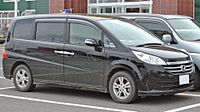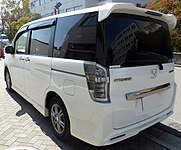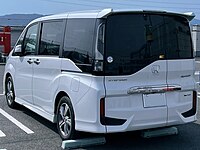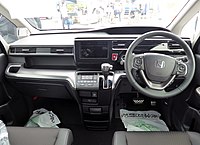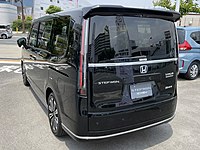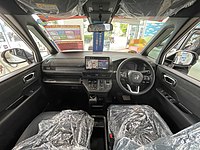auto.wikisort.org - Automobile
The Honda Stepwgn (stylised as STEPWGN, pronounced "step wagon") is a minivan produced by Honda since 1996. It is designed with a higher cabin, in contrast to the Odyssey and also the Stream respectively. Additionally, it can accommodate eight people, instead of seven in the Odyssey and Stream. For its first two generations the car had one door on the driver's side and two doors on the passenger's side.
| Honda Stepwgn | |
|---|---|
 2018 Honda Stepwgn Spada (RP3) | |
| Overview | |
| Manufacturer | Honda |
| Production | 1996–present |
| Assembly | Japan: Sayama, Saitama (Sayama Plant) |
| Body and chassis | |
| Class | Minivan |
| Layout | Front-engine, front-wheel-drive Front-engine, four-wheel-drive |
First generation (RF1/2; 1996)
| First generation (RF1/2) | |
|---|---|
 Honda Stepwgn (pre-facelift) | |
| Overview | |
| Production | 1996–2001 |
| Body and chassis | |
| Body style | 4-door minivan |
| Powertrain | |
| Engine | 2.0 L (122.0 cu in) B20B 125 PS (91.9 kW) I4 |
| Transmission | 4-speed automatic |
| Dimensions | |
| Wheelbase | 2,855 mm (112 in) |
| Length | 4,705 mm (185 in) |
| Width | 1,695 mm (67 in) |
| Height | 1,815 mm (71 in) |
| Curb weight | 1,410–1,645 kg (3,109–3,627 lb) |
F-MX (1995)
The first generation Stepwgn originally appeared at the Tokyo Motor Show as the "F-MX" in 1995.

Initial release (1996)
Japanese sales began on 8 May 1996. At that time, most rival Japanese vehicles usually had the engine mounted under the driver's seat, or a cabover type. The Stepwgn used the latter, and was based on the Civic, to keep prices low - starting from ¥1,548,000 and going up to ¥2,368,000.[1] The passenger side was fitted with a sliding door, to allow easier access. To improve profitability, cost reduction measures were used, such as there being only one engine and transmission option; a two-litre inline-four and a CVT (continuously variable transmission automatic),[2] and the vehicle design reduced the use of steel panels and parts.
1997 update
Changes for 1997 included standardizing ABS and dual SRS airbags throughout the range and further addition of a number of convenience features.
Japanese models went on sale in August 1997 at Honda's Primo, Verno and Clio networks.[3]
Stepwgn Field Deck (1998)
A version of the Stepwgn with pop-up observation tent, designed for outdoor leisure pursuits and made out of fiber-reinforced plastic (FRP).
The models went on sale in Japan from January 1998, at Honda auto dealers.[4]
1999 update
The vehicle received a facelift in May 1999. The appearance of the headlights was altered, and the rear license plate position was moved down.
- Honda Stepwgn (facelift)
- Honda Stepwgn (facelift)
Second generation (RF3/4/5/6/7/8; 2001)
| Second generation (RF3/4/5/6/7/8) | |
|---|---|
 Honda Stepwgn (pre-facelift) | |
| Overview | |
| Production | 2001–2005 |
| Body and chassis | |
| Body style | 4-door minivan |
| Powertrain | |
| Engine | 2.0 L (122.0 cu in) K20A 160 PS (117.7 kW) I4 2.4 L (146.5 cu in) K24A 162 PS (119.2 kW) I4 [5] |
| Transmission | 4-speed automatic (2.0L) 5-speed automatic (2.4L) |
| Dimensions | |
| Wheelbase | 2,855 mm (112 in) |
| Length | 4,705 mm (185 in) |
| Width | 1,695 mm (67 in) |
| Height | 1,815 mm (71 in) |
| Curb weight | 1,490–1,620 kg (3,285–3,571 lb) |
Initial release

The second generation Stepwgn debuted in April 2001, largely based on the first generation's design.
The second generation Stepwgn used a design that was geared towards families with children. The Stepwgn retained its sliding doors located on one side of the vehicle. The vehicle's seating allows four different seating arrangements: "play mode" (sitting opposite each other), "food mode", "sleep mode" and "cargo mode" (the second row of seats is folded flat). A 2.0L Honda K engine DOHC i-VTEC engine powers the second generation Stepwgn, providing 160 PS (117.7 kW; 157.8 hp), improving both driving performance and fuel economy. Some parts were stiffened in order to further enhance driving performance.
The vehicle was unveiled at the 35th Tokyo Motor Show.[6]
Stepwgn, Stepwgn Almas (2001)
The Stepwgn Almas includes conventional side door lift model or passenger seat lift mechanism
Early models include i-Series 2.0-liter DOHC i-VTEC engine. Stepwgn Almas models went on sale on 11 June 2001.[7]
2003 update
In June 2003, Honda significantly modified the design: both the front and rear fascias were altered to fit the look of other Honda vehicles, and the "Spada" series was introduced, available with a 2.4L K24A DOHC i-VTEC, producing 162 PS (119.2 kW; 159.8 hp), and unique fenders.
The vehicle was unveiled at the 37th Tokyo Motor Show in 2003.[8][9]
- Honda Stepwgn (facelift)
- Honda Stepwgn Spada (facelift)
- Honda Stepwgn Spada (facelift)
Production
For the first 6 months of year 2004, sales of the Stepwgn in Japan reached 24,389 units.[10]
Third generation (RG; 2005)
| Third generation (RG) | |
|---|---|
 2005–2007 Honda Stepwgn (pre-facelift) | |
| Overview | |
| Production | 2005–2009 |
| Body and chassis | |
| Body style | 5-door minivan |
| Powertrain | |
| Engine | 2.0 L (122.0 cu in) K20A 155 PS (114.0 kW) I4[11] 2.4 L (146.5 cu in) 162 PS (119.2 kW) K24A I4[12] |
| Transmission | 4-speed automatic (2.0L) 5-speed automatic (2.4L 4WD) CVT (2.4L FWD) |
| Dimensions | |
| Wheelbase | 2,855 mm (112 in) |
| Length | 4,630 mm (182 in) |
| Width | 1,695 mm (67 in) |
| Height | 1,770 mm (70 in) |
| Curb weight | 1,540–1,660 kg (3,395–3,660 lb) |
The third generation Stepwgn had a much more aerodynamic design.
Honda announced the third generation Stepwgn on 26 May 2005. Unlike the previous generations, which only featured sliding doors on one side, the third generation featured sliding doors on both sides, in order to compete with other minivans such as the Nissan Serena and Toyota Noah. Although the size of the car was shrunk, interior accommodation space remained unchanged thanks to a new low-platform chassis which also improved the handling of the vehicle. The overall length had also been shortened, although the platform retains the Civic-based design and employs a thin plastic fuel tank in order to provide a low floor, which was covered in fake wood. The Stepwgn was available with a double wishbone-type suspension with an FF axle or a de-Dion style suspension (4WD models).
Japanese models went on sale in May 2005 at Honda automobile dealers.[13]
- 2005–2007 Honda Stepwgn (pre-facelift)
- 2007–2009 Honda Stepwgn (facelift)
- 2007–2009 Honda Stepwgn (facelift)
- 2007–2009 Honda Stepwgn Spada (facelift)
- 2007–2009 Honda Stepwgn Spada (facelift)
2006 Tokyo Auto Salon concept (2006)
Modulo Stepwgn Concept is a concept vehicle based on Stepwgn, with around-vehicle sensors.
Stepwgn Modulo Concept X Final Room is a concept vehicle based on Stepwgn, with around-vehicle sensors.
The vehicles were unveiled at the 2006 Tokyo Auto Salon.[14][15][16]
2006 update
Changes include:
- addition of G side lift-up seat car and front passenger lift-up seat car models
- G, G S-package, 24Z include power slide door (rear left side) as standard
- G L-package, G LS-package include power slide door (rear right side) as standard
- new setting for smart key system (with 2 keys)
- hydrophilic/heated door mirror+front door wiper glass.
Japanese models went on sale in May 2006.[17]
Timing Belt: The third generation uses a chain timing belt as the engine is an interference type. Timing chain is the better approach for interference engines as they last the life of the engine.
Engines
The third generation Stepwgn is powered by either a 2.0L K20A engine rated 155 PS (114.0 kW), or a 2.4L K24A engine rated 162 PS (119.2 kW).
Transmissions
The 2.0L model retained a 4-speed automatic transmission, whilst the FWD 2.4L model was fitted with a CVT transmission.
Production
At the month of November 2005, sales of Stepwgn in Japan reached 7,093 units.[18]
Fourth generation (RK; 2009)
| Fourth generation (RK) | |
|---|---|
 Honda Stepwgn (pre-facelift) | |
| Overview | |
| Production | 2009–2015 |
| Body and chassis | |
| Body style | 5-door minivan |
| Powertrain | |
| Engine | 2.0 L (122 cu in) R20A 150 PS (110.3 kW) I4[19] |
| Transmission | 5-speed automatic CVT |
| Dimensions | |
| Wheelbase | 2,855 mm (112 in) |
| Length | 4,690 mm (185 in) |
| Width | 1,695 mm (67 in) |
| Height | 1,815 mm (71 in) |
| Curb weight | 1,580–1,750 kg (3,483–3,858 lb) |
The fourth generation Stepwgn is a full redesign of the model. The new model increased in height and length, but remained the same width, when compared to the previous generation. The Stepwgn Spada model returned, keeping its unique grille and headlamp design. The Stepwgn is available in seven trim levels: G, G L Package, L, Li, Spada S, Spada Z and Spada Zi. The 2.4-litre engine was dropped from the lineup, with only a 2.0-litre petrol option currently available. The Stepwgn is available with either front- or four-wheel-drive across the range.[20]
Japanese models went on sale in October 2009. Early models include Stepwgn, Stepwgn special-needs vehicle. Stepwgn Spada and Stepwgn Spada special-needs vehicle were added on 23 October 2009.[21]
- 2009 Honda Stepwgn (pre-facelift)
- Honda Stepwgn Spada (pre-facelift)
- Honda Stepwgn Spada (pre-facelift)
- Interior
Facelift
In 2012, there were minor changes to the Stepwgn, including a new front grille, a new front bumper, new rear lights and rims. Also, a parking camera was included in all models.
- Honda Stepwgn Spada (facelift)
- Honda Stepwgn Spada (facelift)
Modulo Stepwgn (2010)
The Modulo Stepwgn is a production vehicle based on the standard Stepwgn.
The vehicle was unveiled at the 2010 Tokyo Auto Salon.[22]
Stepwgn Modulo Style (2013)
The Stepwgn Modulo Style is a concept vehicle based on the standard Stepwgn.
The vehicle was unveiled at the 2013 Tokyo Auto Salon.[23]
Production
For the month of July 2013, sales of the Stepwgn reached 6,715 units.[24]
Fifth generation (RP1–5; 2015)
| Fifth generation (RP1–5) | |
|---|---|
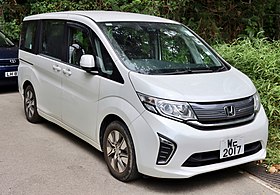 2015 Honda Stepwgn (RP3; pre-facelift) | |
| Overview | |
| Production | 2015–2022 |
| Body and chassis | |
| Body style | 5-door minivan |
| Powertrain | |
| Engine | 1.5L L15BF turbocharger I4 1.5L Honda LFA R-series HEV I4 2.0 L LFA1/LFB1 PGM-FI DOHC i-VTEC I4 + 2 electric motors |
| Electric motor | 2x Permanent Magnet Motors |
| Power output | 110 kW (150 PS; 148 hp) () 158 kW (215 PS; 212 hp) (Hybrid / e:HEV) |
| Transmission | CVT |
| Hybrid drivetrain | Honda Sport Hybrid Intelligent Multi Mode Drive (i-MMD) |
| Dimensions | |
| Wheelbase | 2,890 mm (114 in) |
| Length | 4,690 mm (185 in) 4,760 mm (187 in) (Spada) |
| Width | 1,695 mm (67 in) |
| Height | 1,840–1,855 mm (72–73 in) |
| Curb weight | 1,630–1,770 kg (3,594–3,902 lb) |
The fifth generation Stepwgn was introduced in April 2015. With an all-new 1.5-liter direct injection VTEC Turbo engine, the fifth generation Stepwgn features a functional cabin space, as well as an innovative tailgate mechanism called the Waku Waku Gate ("Waku Waku" meaning "exciting" in Japanese). The Waku Waku gate is a unique proposition as the rear doors either function as a wide tailgate that opens up or a sub-door that opens to the side.[25] It can be used to get out of the third row seat smoothly and to easily store small cargo without folding.
- 2015 Honda Stepwgn (RP3; pre-facelift)
- Honda Stepwgn Spada Cool Spirit (RP3; pre-facelift)
- Honda Stepwgn Spada Cool Spirit (RP3; pre-facelift)
- Honda Stepwgn Modulo X (RP3; pre-facelift)
- Honda Stepwgn Modulo X (RP3; pre-facelift)
Facelift
The Stepwgn got refreshed[26] in September 2017. The Stepwgn Spada Hybrid has a 3 mode powertrain which can switch to being run on EV, Hybrid, or Engine drive mode. It also has a Sport drive mode.[27]
It is equipped with Honda Sensing and can park on its own perpendicularly and parallel by controlling steering.[28]
- Honda Stepwgn e:HEV Spada G EX Honda Sensing (RP5; facelift)
- Honda Stepwgn e:HEV Spada G EX Honda Sensing (RP5; facelift)
- Honda Stepwgn Modulo X Honda Sensing (RP3; facelift)
- Honda Stepwgn Modulo X Honda Sensing (RP3; facelift)
- Interior
Sixth generation (RP6–8; 2022)
The sixth-generation Stepwgn was unveiled on 7 January 2022.[29][30] It is available in three models: Air, Spada and Spada Premium Line. For this generation, the "Waku Waku Gate" mechanism was dropped, in favour of a conventional automatic tailgate release.[31]
- Stepwgn e:HEV Air rear view
- Stepwgn e:HEV Spada
- Stepwgn e:HEV Spada Premium Line rear view
- Interior
References
- "HONDA STEPWAGON catalog - reviews, pics, specs and prices | Goo-net Exchange". Archived from the original on 2013-01-24. Retrieved 2012-12-28.
- "Detailed specs review of 1997 Honda Stepwgn Whitey offered since mid-year 1997 for Japan". www.automobile-catalog.com.
- "Honda's StepWGN (Step Wagon) Goes Through a Minor Model Change".
- "Honda Launches Step WGN Field Deck with Pop-Up Roof".
- "Detailed specs review of 2003 Honda Stepwgn Spada 24T offered since mid-year 2003 for Japan". www.automobile-catalog.com.
- "Honda Automobile / Motorcycle Booth at the 35th Tokyo Motor Show".
- "Honda Announces Full Model Changes for "STEP WGN" and "STEP WGN ALMAS"".
- "37th Tokyo Motor Show 2003 - Production Vehicles".
- "Honda Announces Automobiles and Motorcycles to be Displayed at the 37th Tokyo Motor Show".
- "Honda Achieves Record Global Auto Production for First Six Months of 2004".
- "Detailed specs review of 2005 Honda Stepwgn B offered since mid-year 2005 for Japan". www.automobile-catalog.com.
- "Detailed specs review of 2005 Honda Stepwgn 24Z offered since mid-year 2005 for Japan". www.automobile-catalog.com.
- "Honda Introduces All-New Step Wagon".
- "【東京オートサロン06】写真蔵…ホンダ ステップワゴン コンセプト". レスポンス(Response.jp).
- "【東京オートサロン06】ケータイ世代へ…ステップワゴン×ファイナル ホーム". レスポンス(Response.jp).
- "【東京オートサロン06】ホンダブースにアシモが…". レスポンス(Response.jp).
- "ホンダ ステップワゴン をマイナーチェンジで装備充実". レスポンス(Response.jp).
- Honda Increases Production in North America due to Strong Sales
- "Detailed specs review of 2009 Honda Stepwgn G offered since October 2009 for Japan". www.automobile-catalog.com.
- "Honda StepWGN available in Japan". Taume News. 2009-10-10. Archived from the original on 2009-10-12. Retrieved 2009-10-10.
- Honda Announces the All-new Step WGN
- Honda to show Insight Sports Modulo Concept, more at Tokyo Auto Salon
- Overview of Honda Exhibit at TOKYO AUTO SALON 2013 with NAPAC
- Honda Sets All-Time Monthly Production Record for Automobile Production in Asia
- "All-New Step WGN MPV Debuts Honda's New 148HP 1.5L VTEC Turbo Engine". April 23, 2015.
- "Honda ステップ ワゴン 公式情報ページ". Honda公式ホームページ (in Japanese). Retrieved 2018-09-30.
- "Honda ステップ ワゴン 公式情報ページ". Honda公式ホームページ.
- "Honda ステップ ワゴン 公式情報ページ". Honda公式ホームページ (in Japanese). Retrieved 2018-09-30.
- "新型「STEP WGN(ステップ ワゴン)」を初公開".
- "Say Hello to the 2022 Honda Step WGN and All Its Boxy Goodness".
- https://paultan.org/2022/01/10/2022-honda-step-wgn-mpv-revealed-no-more-waku-waku-gate-petrol-and-ehev-variants-to-be-offered/ [bare URL]
External links
- Official website (Japan)
На других языках
[de] Honda StepWGN
Der Honda StepWGN ist ein Minivan bzw. MPV, den Honda seit 1996 produziert. Die Sitzposition ist höher als die später entwickelten Honda Odyssey und Honda Stream. Im Gegensatz zu diesen kann er statt mit nur sieben auch mit acht Sitzen geordert werden. In der Standardausführung verfügt er über nur eine Tür auf der Fahrerseite und zwei Türen auf der Beifahrerseite. Der englische Name StepWGN steht für "Stepwagon".- [en] Honda Stepwgn
[fr] Honda Stepwgn
La Honda Stepwgn est un monospace vendu depuis 1996 au Japon, sa dernière génération date d'octobre 2009.Другой контент может иметь иную лицензию. Перед использованием материалов сайта WikiSort.org внимательно изучите правила лицензирования конкретных элементов наполнения сайта.
WikiSort.org - проект по пересортировке и дополнению контента Википедии






